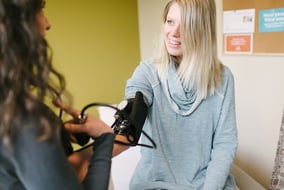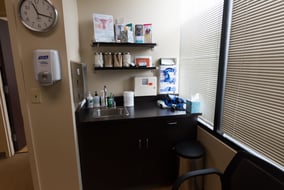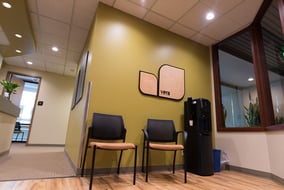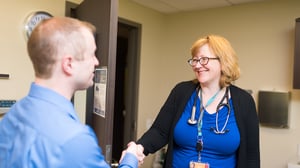As we approach the one-year mark in the COVID-19 pandemic, the researchers who have been working hard since the onset of the pandemic have made vaccines a reality. Two vaccines have received emergency use authorization (EUA) from the FDA, and already more than 45 million vaccines have been administered across the US.
You probably have questions about who’s eligible for the vaccine and when, whether the vaccine is safe and effective, and how Vera can help you learn about and get the vaccine.
We know the past year has been stressful and we are here for you — from health coaching to the preventive and urgent care that’s available virtually and in-person. And when it comes to the COVID-19 vaccine, we’ll be updating you as we get more information and are ready to help you get vaccinated.

A brief recap of COVID-19
By now we know well that coronaviruses are a group of related RNA viruses that cause diseases in mammals and birds. They’re named for the crown of spike protein projections that gives the group its name. Human coronaviruses can cause lower-respiratory tract illnesses, such as pneumonia or bronchitis. SARS-CoV-2 (the virus that causes the illness COVID-19) is a novel form of coronavirus identified in 2019. Like all viruses, SARS-CoV-2 is expected to evolve over time.
Transmission and symptoms
COVID-19 is usually spread through close contact from person to person, and sometimes spreads via airborne transmission, from exposure to respiratory droplets through coughing, sneezing, or talking. This is why people who are within six feet of a person with COVID-19, or who have direct contact with that person, are at the greatest risk of infection. You can also be exposed to it when you shake hands or have other close contact. A less common way COVID-19 spreads is by touching a contaminated object and then touching your face.
One of the more unusual aspects of COVID-19 is that it has a wide range of symptoms. In some cases, it doesn’t show symptoms at all.
Infected people are more likely to be contagious early in the disease process. Anyone can have mild to severe symptoms which may appear 2-14 days after exposure. Please call your Vera Care Center if you think you were exposed to COVID-19 or have a fever or cough.

A person showing the following symptoms may have COVID-19 and getting a test is the only way to know for sure:
- Cough
- Fever
- Nasal congestion
- Sore throat
- Loss of taste and/or smell
- Occasionally nausea, vomiting, or diarrhea
Because it’s possible to be infected with and transmit COVID-19 without showing any symptoms, it’s especially important to follow the mask-wearing, social-distancing, and hand-washing guidelines.
Where are we now?
Infections continue to occur worldwide, and new variants of the virus have been detected in several countries, including the US. Every week that goes by, we learn a bit more about the virus. While it may be worrying to hear that new variants are emerging in some parts of the world, the good news is that the best way to prevent further spread of variants is to get as many people as possible vaccinated as soon as possible.
Testing for COVID-19
Testing is also evolving and, while each test has its strengths and weaknesses, PCR seems to be the most accurate test for active infections. Several testing options are available at all Vera care centers. Vera is also working with some employers to provide in-home testing kits.

Comparing test options
As always, please check with your care center to see which tests are available.
- Quest or LabCorp PCR nasal swab: Best for detecting COVID-19 before symptoms start and throughout a COVID-19 illness. It can take several days to get a result.
- CRL saliva PCR test: Just as accurate as the nasal PCR test and doesn't require a potentially uncomfortable nasal swab. This test also takes a couple days to get a result.
- Abbott ID Now rapid screening test: Best for patients who just started to have symptoms and need a fast result. It's not a great option for people who don't have symptoms or who are well into their course of illness. Also, it may not be as accurate for asymptomatic testing.
Advantages of the saliva-based test
- Slightly faster turnaround time — results are available within 48 hours
- Less invasive — you just spit into a tube
- Can be done at home
- Free for Vera members
Be sure to avoid eating, drinking, or smoking for 30 minutes before you take the saliva test.
Preventing COVID-19 infections
As we try to overcome pandemic fatigue and push forward with immunizations, washing your hands often, wearing masks, and observing social distancing are still critical actions to take. It's important to stay at least six feet apart and avoid crowds as well as people who are sick.
It is also recommended that you seek out well-ventilated spaces, avoid touching your face, and get tested.

Getting the vaccine
COVID-19 vaccines have been shown to be highly effective at preventing COVID-19 and may also keep you from getting seriously ill even if you do get COVID-19. Once you've been vaccinated, your body can fight the virus if you're exposed.
Who's eligible for the COVID-19 vaccine?
The CDC has provided recommendations for who should be offered the vaccine first, as supplies are limited. The goal is for everyone to easily get a COVID-19 vaccine as soon as large quantities of vaccine have been produced and distributed.
Each state has its own plan for vaccine prioritization, distribution, and allocation, so check your state guidelines. Vera is working with local and state agencies to get access to vaccines. For example, Washington State's Phase Finder Tool shows who is eligible and when.
The COVID-19 vaccine is free for eligible Vera members, and we'll notify you once vaccines are available at your care center.
Which vaccines is Vera administering?
The two vaccines that are authorized and recommended to prevent COVID-19 in the US require two doses to be effective. Once you receive the first dose, your second dose should also be from the same brand.
Pfizer / BioNTech COVID-19 Vaccine
- Available now for people 16 and older
- Two doses, 21 days apart
- Very important to get both primary and booster
- Approximately 95% effective for those who receive both doses
- Available now for people 18 and older
- Two doses, 28 days apart
- Very important to get both primary and booster
- Approximately 94-95% effective for those who receive both doses
You should wait 14 days between the COVID vaccine and any other vaccine. However, if you happen to receive another vaccine within 14 days, you don't need to restart your COVID vaccine cycle.
It’s also important to note that vaccines work best if everyone gets one as soon as you’re able, and will help protect you against any variants.
Some other frequently asked questions

Side effects
After receiving the vaccine, your arm may be sore, red, or warm to the touch. Some people report getting a headache or fever afterwards. These symptoms usually go away on their own within a few days. The mild side effects are a sign that your immune system is doing exactly what it's supposed to do: developing antibodies to protect against COVID-19.
You should get the second dose even if you experienced mild side effects from the first dose, unless your physician instructs you otherwise.
Who shouldn't get vaccinated
Although a small number of people experience anaphylaxis — a severe allergic reaction — this is extremely rare. After you receive the vaccine, you'll be asked to stay for 15 minutes for observation, in the unlikely event that you need immediate treatment for a reaction.
Anyone who has experienced a severe allergic reaction to any mRNA COVID-19 vaccine, or to polysorbate, should not be vaccinated. Although polysorbate is not an ingredient in the current vaccines, it is similar to polyethylene glycol, which is a part of other vaccines.
Are the vaccines safe?
The COVID-19 vaccines are safe and effective. They were tested in large clinical trials to make sure they meet safety standards. Many people were recruited to participate in these trials to confirm that the vaccines offer protection for people of different ages, races, and ethnicities, as well as for people with different medical conditions.
In clinical trials for the approved vaccines, people who received a vaccine either did not get COVID-19, or only had mild symptoms of the illness. There's good evidence that vaccination will prevent asymptomatic transmission, but more time is needed to determine that for sure.
How were the vaccines developed?
Vaccine development consists of three phases. Typically, these occur in sequence, with each phase taking years. For COVID-19, this process was accelerated, with phases occurring in parallel and no steps skipped. SARS and MERS helped pave the way for COVID-19 vaccination — pre-clinical studies were already available to build upon.
The COVID-19 vaccines available today are based on mRNA technology that researchers have been studying and working with for decades. It's important to note that mRNA does NOT use a live virus; you are not being injected with COVID-19. And these vaccines do NOT interact with or change your DNA. mRNA vaccines instruct our cells to make a piece of protein that triggers an immune response, which produces antibodies.
The primary ingredients for both vaccines are spike protein mRNA, a liquid capsule to encapsulate the payload and other ingredients to keep it stable. The vaccines do NOT contain eggs, preservatives, or latex.
Vaccine guidance for special populations
COVID-19 vaccinations are recommended even for people with autoimmune conditions, who are pregnant, or who have had Guillain-Barré syndrome. If you have concerns, talk with your provider to make an informed decision.
Patients who are pregnant have an elevated risk for COVID-19. The American College of Obstetricians and Gynecologists (ACOG) has published guidelines for vaccination. They recommend that COVID-19 vaccines should NOT be withheld from pregnant individuals who otherwise meet the criteria for vaccination.
No vaccines have been approved for children under age 16 yet.
V-safe health checker tool
V-safe is a voluntary, smartphone-based service from the CDC that provides personalized health check-ins after you receive a COVID-19 vaccine. It will also remind you to get your second COVID-19 vaccine dose.
There's no app to download, since it works with the existing web browser and text messaging tools on your phone.
The path forward
While the arrival of the COVID-19 vaccine is encouraging news, we still have to practice patience and vigilance in order to stop the pandemic.

Preventive measures such as wearing masks, staying six feet apart, and avoiding crowds go far in reducing your exposure to COVID-19. These measures, coupled with vaccination, give you the best protection against the virus.
A vaccine works with your immune system to create an antibody response that can fight the virus if you’re exposed. It’s a safe way to protect yourself and others.
Herd immunity means that a community is protected against future outbreaks of a disease because a large enough portion of the population has been vaccinated.
Although herd immunity may be a number of months away, every COVID-19 vaccine administered takes us one step closer to stopping the pandemic. Vera is your partner in the journey towards better health, and we look forward to providing you with the COVID-19 vaccine as soon as vaccine supplies and eligibility permit.
Click here to register for our free COVID-19 vaccine webinar
Sign up
Join our email list to receive the latest open positions, Vera Careers news, and more.





